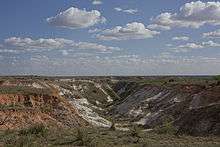Ogallala Formation

East side of Blanco Canyon — showing the red-colored Ogallala formation and the bright white color of the Blanco formation.
The Ogallala Formation is a Miocene to Pliocene geologic unit in the High Plains of the western United States and the location of the Ogallala Aquifer.[1]. Notably, it records the North American Land Mammal Ages (NALMAs) Hemphillian, Clarendonian, and Barstovian.[2] The Ogallala Formation outcrops of Lake Meredith National Recreation Area preserve fish fossils.[3] Similar specimens from the same formation are found at Alibates Flint Quarries National Monument in Texas.[3]
See also
References
- Footnotes
- ↑ Rex C. Buchanan, B. Brownie Wilson, Robert R. Buddemeier, and James J. Butler, Jr. "The High Plains Aquifer". Kansas Geological Survey, Public Information Circular (PIC) 18.
- ↑ Greg A. Ludvigson, Robert S. Sawin, Evan K. Franseen, W. Lynn Watney, Ronald R. West, and Jon J. Smith. "A Review of the Stratigraphy of the Ogallala Formation and Revision of Neogene ("Tertiary") Nomenclature in Kansas". Kansas Geological Survey, Current Research in Earth Sciences, Bulletin 256, part 2.
- 1 2 "Lake Meredith National Recreation Area," Hunt, Santucci, and Kenworthy (2006); page 67.
- Sources
- Hunt, ReBecca K., Vincent L. Santucci and Jason Kenworthy. 2006. "A preliminary inventory of fossil fish from National Park Service units." in S.G. Lucas, J.A. Spielmann, P.M. Hester, J.P. Kenworthy, and V.L. Santucci (ed.s), Fossils from Federal Lands. New Mexico Museum of Natural History and Science Bulletin 34, pp. 63–69.
This article is issued from
Wikipedia.
The text is licensed under Creative Commons - Attribution - Sharealike.
Additional terms may apply for the media files.